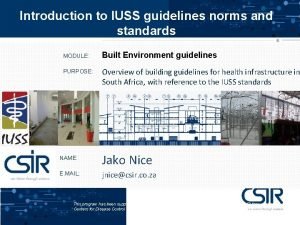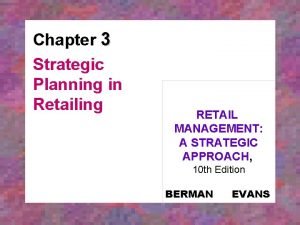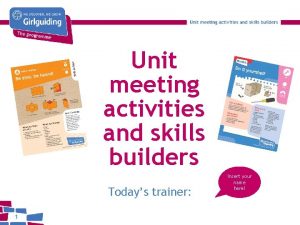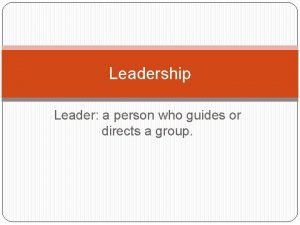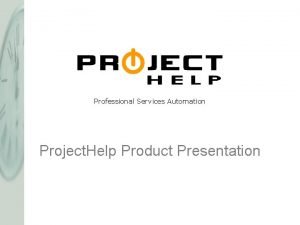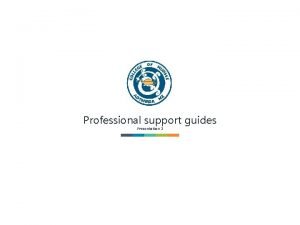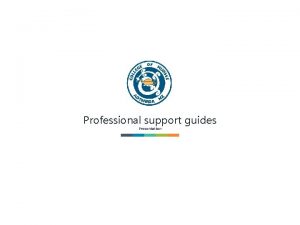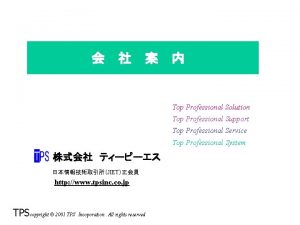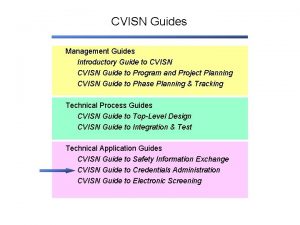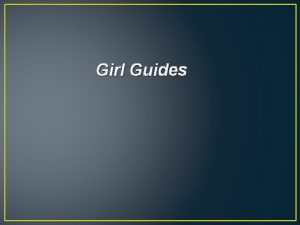Professional support guides Presentation 4 The Support guides

















- Slides: 17

Professional support guides Presentation 4

The Support guides 4 Presentations 1. About us 2. Portfolios Who we are Why we do portfolios Bullying defined College purpose How to create a portfolio for a NCNZ recertification audit Recognising bullying Membership options Benefits/ Indemnity Hard copy Electronic 3. Bullying Reporting bullying Managing a bullying situation www. nurse. org. nz 4. Practice issues Employer: How to manage performance improvement or disciplinary processes Employee: How to engage successfully in a performance improvement process Dealing with a disciplinary process

Practice issues Presentation 4 Employer: How to manage performance improvement or disciplinary processes Employee: How to engage successfully in a performance improvement process Dealing with a disciplinary process

Section 1. For employers/ managers/ nurse leaders This section is about How to manage • performance improvement processes • disciplinary processes

Managing practice issues or disciplinary problems? Stop, gather information, plan Performance management or disciplinary issues can be extremely challenging. Do not blunder into a performance management process. Poor process may adversely affect outcome www. nurse. org. nz

What are. Defining you dealing with? performance issues Performance management? Disciplinary? VS Organisational process to ensure employees are aware of the level of performance expected of them in a role, as well as any specific objectives they will need to achieve overall objectives and/or regulatory competencies. Encompasses performance improvement plans and processes. A process for dealing with perceived employee misconduct. Organisations will typically have a range of disciplinary procedures depending on the severity of the transgression. www. nurse. org. nz

Performance management? Managing a performance improvement plan A good employer will…. . Ensure the staff are fully aware of performance goals and expected behaviour If issues with practice are identified, meet to discuss and set an agreed, fair and reasonable, time-framed, goal orientated plan Ensure the employee has opportunity and time to meet the goals e. g. training, supervision. Be fair and transparent about consequences on non achievement of agreed goals. Stick to the plan: Review the plan and goals in the timeframe agreed. Any change to the plan must be agreed between both parties Staff need to be informed if their practice or behaviour is not meeting standards. If a nurse is unaware he/she is not meeting standards how can they improve? www. nurse. org. nz

Disciplinary? Managing a disciplinary process Some key tips… Gather information Follow policy and procedure Only deal with facts Get advice Act in good faith. A good employer will have policies and procedures for performance management which are underpinned by legislation. Don’t deal with extraneous, irrelevant issues or hearsay, only use the facts Check process with your HR department or relevant senior manager (if appropriate). Gather all the information you need. Keep the investigation and information confidential. Stay 100% professional and impartial. Employers must stick to policy, fair process and natural justice. Deal only with the specific issue at hand. Don’t muddy the waters, remain neutral. They may advise obtaining legal advice to make sure you and the organisation are kept safe. You must have a support person in formal disciplinary meetings. Plan and document Keep all documentation. Retain copies of all conversations, texts, emails and meetings. Take minutes of face to face meetings and notes of telephone calls. Start considering your course of action, plan ahead. Follow a fair process There may be an informal meeting followed by a formal investigation. In a formal disciplinary meeting make sure the staff member has a fair chance to respond to the allegations. See next slides for process….

This is only a template for a disciplinary process, it doesn’t replace your organisational processes… if you have them. The disciplinary process A 10 step template process to follow…. . 1. Informal meeting Ask the staff member to attend to let them know the allegations and that you will carry out a formal investigation. Minutes are not required, but note you have had the meeting. 2. Investigate Gather all the information your can around the allegation e. g. documents, notes, statements. 3. Consider your findings Fully review what you have found throughout the investigation. Focus on the original allegation. Get advice to help make your decision from another manager or in some cases, from a legal advisor. www. nurse. org. nz

4. Write a formal letter to the staff member informing them of either: (a) Insufficient evidence to proceed or (b) Invite to a disciplinary meeting. Include that they have a right to bring a support person. Suggest a date and time (be prepared to reschedule if required, but not indefinitely). Include all information gathered during the investigation for their consideration. 5. Be prepared Review all the evidence again before the meeting 6. Formal meeting first steps Do not attend alone. Make it clear who is leading the proceedings and who is the note taker. Stick to the points made in the disciplinary letter. Don’t go off on a tangent. 7. Formal meeting structure Read out aloud the letter they were sent. Review all the evidence from the investigation. Offer the opportunity to respond. Once they have responded and have no more to say, take an adjournment. www. nurse. org. nz

8. Adjournment Consider the matter now you have feedback from the staff member involved. Come to a decision based on your evidence and their feedback. If unable to make a decision e. g. more investigation is now indicated, then take a prolonged adjournment. Agree a time/ date to reconvene. 9. Reconvene and decision Present any further evidence gathered (if this is the case). Tell them your decision. This may range from: • No action • Written warning • Final written warning • Dismissal. Allow them time to respond. If you are able, get them to sign the hand written minutes as a true record. If they ask, provide a transcript and copy of hand written minutes. 10. Follow-up formal letter Send a formal letter to confirm the outcome of the process. www. nurse. org. nz

Council issue vs employment issue When to contact Nursing Council …. . A Council issue? The Council’s role is to protect the health and safety of the public by ensuring that nurses are competent and fit to practise. The Council carries out this role by considering the competence, health or conduct of a nurse and deciding whether the nurse should have to comply with certain conditions in order to practise. An employment issue ? An employer should not use referral to Nursing Council as a proxy for carrying out a robust performance improvement or disciplinary process. Examples of internal disciplinary triggers may include; not following policy or procedure, repeated lateness, rudeness, bullying or failure to follow reasonable instructions from a Manager. Generally speaking a performance improvement or internal disciplinary process should precede consideration of referral to Nursing Council. Where to get The Nursing Council website provides comprehensive information on when to contact them about a nurse. advice Competence, conduct, health, HRANZ guidelines for Competence Referrals (2010), court convictions, practicing without an APC, practicing outside scope, breaching conditions, Health Practitioners Disciplinary Tribunal. http: //www. nursingcouncil. org. nz/Employers/Fitness-to-practice

Section 2. For employees This section is about How to engage successfully in a performance improvement process Dealing with a disciplinary process

Engaging successfully. Aiminfor aapositive performance improvement outcome process Get support Reflect on your practice It’s okay to ask for help Talk to friends or family. Get professional support and advice. Consider taking a support person to meetings Use the Employee Assistance programme (EAP) or similar services Take time to reflect on your practice… what could you do better? Listen carefully to feedback Are you meeting your regulatory requirements …the Nursing Council competencies for your scope? Are you providing the best care possible for your patients? Stick to the agreed plan Know your Do you need a support person? rights Is the improvement plan clear to you? Once you have agreed to a plan focus on the goals and how to achieve them. If you are struggling to meet them, keep your employer informed. Does the plan give you timeframes, measurable goals and opportunity to meet those goals? Is the process fair and transparent? This can be a challenging time, so remember to take care of yourself. Remain 100% professional and focus on improving your practice. www. nurse. org. nz

The disciplinary process How to approach… Get support It’s okay to ask for help Get professional support and advice. Take a support person to meetings Use the Employee Assistance programme (EAP) or similar services Be specific Focus your response to the issues raised in the disciplinary notification. Be prepared Gather all relevant information, which could be from document review, staff interview or third party evidence. Ensure you have read all the evidence provided by your employer to allow you to respond fully to the allegation. Right to appeal Don’t forget you can appeal a disciplinary decision if you feel you have not been fairly treated through the process, this is initially through a more senior manager in the organisation but ultimately you have the right to lodge a personal grievance. This can be a challenging time, so remember to take care of yourself. Remain 100% professional. www. nurse. org. nz

For more information… http: //www. nurse. org. nz/ admin@nurse. org. nz

The end Check out our other professional support presentations About us Portfolios Bullying
 Anticipation guide examples
Anticipation guide examples My blood begins my safer guides to rule
My blood begins my safer guides to rule Unisa library guides
Unisa library guides Iuss standards
Iuss standards Strategic planning in retailing
Strategic planning in retailing How to change artboard units in illustrator
How to change artboard units in illustrator Cylinder head guides
Cylinder head guides Association of ukrainian guides
Association of ukrainian guides Unit meeting
Unit meeting Orange section erg
Orange section erg Munis training manual
Munis training manual Bulbul promise
Bulbul promise Whose voice guides your choice
Whose voice guides your choice Wwc practice guides
Wwc practice guides God guides me
God guides me The person who guides
The person who guides Aicpa code of professional conduct summary
Aicpa code of professional conduct summary Professional services presentation
Professional services presentation



